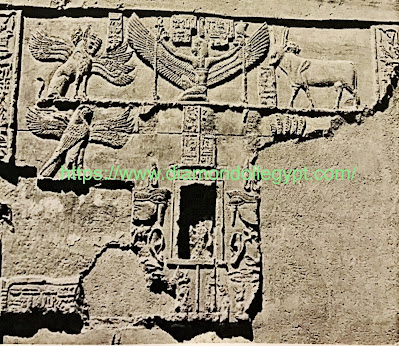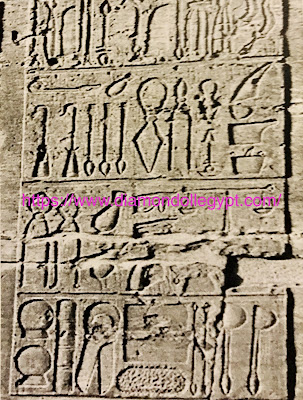What is it ?
Do you remember it that we told before entering the temple? This painting depicts , Mast the god of order (justice), dividing the land of the city into two parts , one belonging to the eagle god and the other to the crocodile god.
A part of this temple was once used as a small clinic and many patients came here for treatment. There are many medical devices carved on the wall here, it goes without saying that the Egyptians’ medical level was already very good according to the types of these devices.
Let us focus on some medical tools, starting with the simple tools.
By looking at the upper right corner of the third row from top to bottom, this tool is too clear.
Everyone knows that scale is used to weigh medicines, and many Chinese hospitals still use this scale for medicine nowadays.
Next we look at the bottom left corner of the bottom row. Everyone knows cupping, right? Many people believe that cupping is discovered by Chinese medicine, but this is not the case , as it was the first record of cupping in the Chinese pharmacopeia in the Qing Dynasty.
Hippocrates, a professor of Ancient Greek medicine, believed that there are four fluids in the human body, which are blood, mucus, yellow and black gallbladder. As long as one of the body fluids is too much, people will get sick, so the excess body fluids should be suctioned out.
“Body fluids theory” is the theoretical basis for cupping in Ancient Greece.
On the mural, the Greek god of medicine (Asclepius), the world’s first cupping jar is depicted, containing two suction cups used to draw human blood. The mural is of over 2,000 years ago.
What is the tool medallion like next to the cupping jar, just guess ?
These are scissors, according to archaeological records, the ancient Egyptians began to use bronze of it in the third century BC, and the shape of it at that time was different from the scissors we use now .
It was invented in the first century AD.
Let us look at the medical instrument, in the lower right corner of the bottom row.
These look like spatulas but in fact, these are a scalpel along with the scissors and other tools we saw earlier, many scholars believe that the Egyptians were the ones who first used them as a modified surgical technique.
After the plastic surgery technique becomes so advanced, do you know the origin of plastic surgery?
The ancient Egyptians believed that after death the soul would return to its body, and the dead will incarnate as an adult with his original body.
In the year 1213 BC, Ramses II, the most famous king of ancient Egypt, died.
Ramesses II was known for his long and large nose.
In order to ensure that the soul can recognise its real body, and to support it smoothly in the next life, priests place bones seeds in his nose through surgery, this is the origin of plastic surgery that we did not know , had it not been for our examination of the ancient Pharaonic mummies.
During the Roman period, plastic surgery developed rapidly and began to be used to improve portraits, such as treating the ears of wealthy women with heavy earrings, helping slaves remove or covering signs of slavery on their bodies, and reconstructing the faces of mutilated Roman soldiers.
Let us see what is this rectangular tool on the right side of the scissors? It is a sponge. In the Greek and Roman periods, people generally collected natural sponges to wipe their bodies and wash dishes.
In the medical field, they mainly used the powerful water sucking function to absorb blood or body fluids, so that surgeons could have a clearer view of the surgery.
The sponge that we are using nowadays is almost all the synthetic sponge that was made from chemical raw materials, while the natural sponge that people use at that time is sponge from an animal.
The sponge animal lives in water and is the most primitive, multicellular animal in the world, and it originated more than 600 million years ago, and some scientists have so far proposed theories that humans originated from a large mud sponge.
Then we look at the equipment on the far left in the second row. The tip of the tool is a hook, as the name implies, it is medical hooks, and it is used to connect the internal organs.
Do you remember ( mummification) ?
Medical prescriptions discovered by the pharaohs before scholars :
The ancient Egyptians discovered treatments for diabetes and infertility :
The antibiotic by the pharaohs
The ancient Egyptians discovered the antibiotics early, extracting it from the mouldy bread mushroom on which the fungus “ Penicillon “ grows, from which the drug “Penicillin “ is extracted.
The ancient Egyptians put powdery mildew on bread, or on a wet cloth in stagnant water using also plants as a type of antibiotic such as castor, onion and garlic. Because antibiotics are substances produced by some types of bacteria and fungi, and they also kill the growth of germs, and are among the most medicines which is still widespread until now and helps to cure many diseases.
Anesthesia
There are 10 methods of treatment for the Pharaohs resulted from research
The Pharaohs reached anesthesia through acupuncture as they also used it to perform delicate operations, such as brain tumors . There was another method of anesthesia, similar to “ Al-bannj “, which is marble stone powder mixed with vinegar.
Al-Bannj was known as “ Memphtish “, which consists of marble stone and vinegar. Later scientific research has proven that marble is a compound of calcium carbonate, which is affected by the acetic present in vinegar, as mentioned in the book “ The secrets of the Pharaohs “, which was published in 1991. By Hassan Saadallah.
Baldness cure
The ancient Egyptians also used non-chemical substances in the treatment of hair loss, and the treatment of baldness through painting the head with a mixture of duck fat, crocodile fat and snake fat. They also use a mixture of lion’s and hippo’s pomade with cat’s fat up to 4 days until the hair begins to grow again.
Using lettuce leaves and fenugreek seeds and putting them on the head of a bald person for a period of time were also other methods in order to regrow hair.
They also used many oils to grow and strengthen hair such as almond, rosemary and castor oil.
Stomach disorders and the digestive system’s treatment
The ancient Egyptians overcame stomach disorders and digestive diseases by drinking boiling herbs.
They also used licorice , which contains glycyrrhizin in the treatment of stomach ulcers and Gastrointestinal diseases .
In addition, the ancient Egyptian doctors used to mix these herbs with bitter medicines to hide the taste of their bitterness.
Treating wrinkles and expelling worms
They cultivated hibiscus, in order to use it in de-worming of children. They also used carrots to treat wrinkles.
Infertility treatment
The Pharaohs also had experiences in women and childbirth, as they managed to know if a woman is pregnant or not by placing the woman’s urine in two containers of barley and wheat grains. If the grains grow in a the bowl of wheat, the woman is pregnant with a girl, and they also found ways to help facilitate labor and the process of childbirth, they prescribed women who are nearing childbirth to eat dates in their diet, and drinking fenugreek to strengthen women in postpartum.
Diabetes treatment
And they used onions in diabetics treatment, and they also managed to knew if the patient had diabetes or not through urine, so if it was sticky like juice or honey, then the patient had diabetes, discovering that onions strengthened the stomach, prevented clots and regulated blood sugar, and that onions contained coconians equal to insulin, as mentioned in the book “ Ancient Egyptian Medicine “, by Dr. Hassan Kamal.
Bronchial and influenza treatment
They discovered aromatherapy, as the patient is given 3 to 4 drops of peppermint oil over a cup of boiling water in case of influenza infection. And it also helps in bronchitis’s medicament.
As for the black seed, it was taken as a daily dose, consisting of 4 drops placed on any drink to reduce cholesterol and as a curative for the digestive system.
The last part of the temple is a well used to measure the level of the Nile water, and the bottom of the well is connected to the Nile.
The level of the Nile water can be judged by the depth of the well water. In addition, the temple was the main authority responsible for taxes in the Greek period.
According to the flood agricultural production’s conditions and tax standards for the year were determined to the state of the Nile.
At that time there was no measuring tape, and the ancient Egyptians used their own arms for measuring, with a person’s arm length being about 54 cm.
They put 8 meters as a standard water level. 54 cm multiplied by 16 arms, about 8 meters, so they set the standard on which the water level in the well is 16 cubits, and if the depth of the well water exceeds 16 arms, this is an indication of flooding, and less than 16 arms, that is an indication of flooding, and less than 16 arms, that is an indication of the occurrence of famine.
The higher of the average well water depth of 16 arms, the lower the tax is . Conversely, the deeper water in the well the closer the 16 arms , the taxis is higher.


Comments
Post a Comment